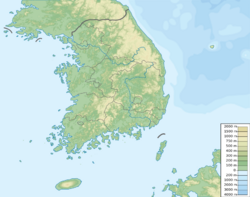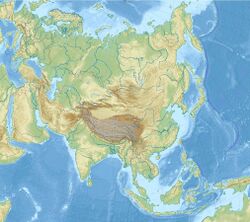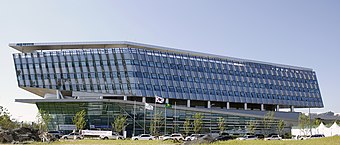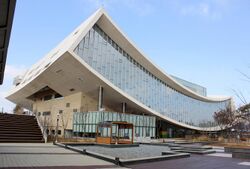Sejong City
Topic: Place
 From HandWiki - Reading time: 10 min
From HandWiki - Reading time: 10 min
| This place needs to be updated. Please update this place to reflect recent events or newly available information. (November 2018) |
Sejong 세종특별자치시 | |
|---|---|
Special Self-Governing city | |
| Sejong Special Self-Governing City | |
| transcription(s) | |
| • Korean | 세종특별자치시 |
| • Hanja | 世宗特別自治市 |
| • Revised Romanization | Sejong Teukbyeol-jachisi |
| • McCune-Reischauer | Sejong T’ŭkpyŏl-chach’isi |
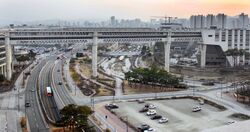 | |
 | |
| <mapframe height="200" zoom="8" frameless="1" width="300">{"properties":{"stroke-width":2,"stroke":"#000000","title":"Sejong City"},"type":"ExternalData","service":"geoshape"}</mapframe> | |
| Coordinates: [ ⚑ ] : 36°29′13″N 127°16′56″E / 36.487002°N 127.282234°E | |
| Country | Republic of Korea |
| Region | Hoseo |
| First settled | 2012 |
| Neighbourhood Town Townships | 12 1 9 |
| Government | |
| • Type | Mayor–Council |
| • Mayor | Choi Min-ho (People Power) |
| • Body | Sejong City Council |
| Area | |
| • Total | 465.23 km2 (179.63 sq mi) |
| Population (October 2020) | |
| • Total | 351,007[1] |
| • Dialect | Chungcheong |
| GDP | |
| • Total | KR₩ 14 trillion US$ 11 billion (2022) |
| Time zone | UTC+9 (Korea Standard Time) |
| Area code(s) | +82-44 |
| Flower | Peach |
| Tree | Pine |
| Bird | Dollarbird |
| Website | Official website (English) |
Sejong or Sejong City (Korean: [seːdʑoŋ] (![]() listen); Korean: 세종; Hanja: 世宗), officially the Sejong Special Self-Governing City[3] (세종특별자치시; 世宗特別自治市), is a special self-governing city and the de facto administrative capital of South Korea .
listen); Korean: 세종; Hanja: 世宗), officially the Sejong Special Self-Governing City[3] (세종특별자치시; 世宗特別自治市), is a special self-governing city and the de facto administrative capital of South Korea .
Sejong was founded in 2007 as the new planned capital of South Korea from many parts of the South Chungcheong province and some parts of North Chungcheong province to ease congestion in South Korea's current capital and largest city, Seoul, and encourage investment in the country's central region. Since 2012, the government of South Korea has relocated numerous ministries and agencies to Sejong, but many still reside in other cities, primarily Seoul, where the National Assembly and many important government bodies remain.
Sejong has a population of 351,007 as of 2020 and covers a geographic area of 465.23 km2 (179.63 sq mi), making it the least-populous and smallest first-level administrative division in South Korea. Sejong is located in the west-central Hoseo region, bordering South Chungcheong to the west, Daejeon Metropolitan City to the south, and North Chungcheong to the east.
The construction of the city is expected to be completed in 2030, at which time 500,000 people are expected to live there.[4]
Name
Sejong was named in honor of King Sejong the Great, the fourth king of the Joseon Dynasty and creator of the Korean alphabet, Hangul.[5] The city was formed by combining Yeongi County, the county of South Chungcheong Province from which the majority of the city's territory was ceded, and other counties.
History
In 2003, then-President Roh Moo-hyun sought to relocate the national capital of South Korea from the metropolitan city of Seoul to a new multifunctional administrative city in the center of the country. The goal was to reduce the influence and dominance of Seoul on national governance and economics, whilst promoting the regional development of other areas of the country.[6] According to the former Interior Minister Maeng Hyung-gyu in 2012, "Sejong is a symbol of the country's efforts toward more balanced regional development," helping to decongest Seoul and spur investment in the country's central region.
In October 2004, the Constitutional Court dealt a setback to President Roh's plans, ruling that the capital must remain in Seoul in response to a complaint filed by the main opposition, the conservative Grand National Party. As such, the Roh administration was forced to modify the project to relocate the majority of government ministries and institutions to Sejong, which would become a special administrative city instead of a new capital. The revised plan was approved by the National Assembly in March 2005. Challenges to the new plan were rejected by the Constitutional Court in November 2005.[6]
When the Grand National Party retook the presidential office in 2008, then-President Lee Myung-bak opposed the idea of moving government agencies, claiming that it would hurt Seoul's global competitiveness and result in inefficiency.[6] Following Lee's directions, plans were made to make Sejong an industrial, science and education hub instead. This plan was opposed by many, including Roh's allies and some members of the ruling Grand National Party, including Lee's arch-rival and eventual successor, Park Geun-hye. Defeat in the mid-2010 local elections forced Lee to present his proposal to the National Assembly where it was voted down.
In July 2012, Sejong Special Self-Governing City was created by combining all of Yeongi County, three townships of Gongju[7] and one township of Cheongwon County.
In April 2013, the city government of Putrajaya, Malaysia signed a letter of intent (LOI) with the government of Sejong City to mark cooperation between the two planned capitals.[8][9]
(As of 2019), 12 ministries were relocated to the city.[10] As such, only 5 ministries continue to remain in Seoul; the Ministry Of Foreign Affairs, Ministry of Unification, Ministry of Justice, Ministry of National Defense, and Ministry of Gender Equality and Family.[11]
Sejong was specifically designed to be a "smart city", and is sometimes referred to as Sejong smart city. It is the leading smart city in Korea, and is often held up as the standard for other cities experimenting with the development of smart city infrastructure.[12]
By 2019, there was disagreement among experts as to whether Sejong had "lived up to expectations. ...Sejong uses its new development to market itself as an alternative to Seoul, offering luxury living at a fraction of the cost. It boasts shiny state-of-the-art condominiums, ample public green space and smart and sustainable city tech, like automated trash collection and zero-waste food disposal, electric car charging and sharing stations, solar-powered buildings, interactive digital signage, closed-circuit television security and fine dust emergency alerts. [It] has sparked criticism that the new city is not only too lackluster to draw residents away from Seoul, but also difficult to access and poorly designed."[13]
Geography
Sejong is surrounded by the two provinces of South and North Chungcheong, as well as the metropolitan city of Daejeon. It is about 121 kilometres (75 mi) south from Seoul.[14]
Cityscape
As of 2012 much of the city was under construction. The residential area, by 2012, had several high-rises built for transferees. At that time the residential area was cordoned off from much of the under-development governmental area and had some restaurants, six schools, and one grocery store.[citation needed]
Climate
Sejong City has a humid continental climate (Köppen: Dwa), but can be considered a borderline humid subtropical climate (Köppen: Cwa) using the −3 °C (27 °F) isotherm. Script error: No such module "weather box".
Administrative divisions
Sejong is divided into 12 haengjeong-dong (administrative neighborhoods), 1 eup (town) and 9 myeon (townships). The 10 haengjeong-dong and Jochiwon-eup is[clarify] the city main urban centre.
| Map | Name | Hangul | Hanja | Population (2020-10)[1] |
Area (km2) |
|---|---|---|---|---|---|

| |||||
| Administrative Neighbourhoods | |||||
| Hansol-dong | 한솔동 | 한솔洞* | 19,385 | 2.75 | |
| Saerom-dong | 새롬동 | 새롬洞* | 29,498 | 4.84 | |
| Dodam-dong | 도담동 | 도담洞* | 36,571 | 4.72 | |
| Areum-dong | 아름동 | 아름洞* | 23,742 | 2.19 | |
| Jongchon-dong | 종촌동 | 宗村洞 | 29,725 | 1.15 | |
| Goun-dong | 고운동 | 고운洞* | 34,476 | 5.35 | |
| Boram-dong | 보람동 | 보람洞* | 19,513 | 1.33 | |
| Daepyeong-dong | 대평동 | 大坪洞 | 10,940 | 1.52 | |
| Sodam-dong | 소담동 | 소담洞* | 31,253 | 4.43 | |
| Dajeong-dong | 다정동 | 다정洞* | |||
| Haemil-dong | 해밀동 | 해밀洞* | |||
| Bangok-dong | 반곡동 | 盤谷洞 | |||
| Towns | |||||
| Jochiwon-eup | 조치원읍 | 鳥致院邑 | 43,086 | 13.56 | |
| Townships | |||||
| Yeongi-myeon | 연기면 | 燕岐面 | 2,672 | 43.93 | |
| Yeondong-myeon | 연동면 | 燕東面 | 3,151 | 28.32 | |
| Bugang-myeon | 부강면 | 芙江面 | 6,191 | 27.79 | |
| Geumnam-myeon | 금남면 | 錦南面 | 8,779 | 78.70 | |
| Janggun-myeon | 장군면 | 將軍面 | 6,639 | 53.23 | |
| Yeonseo-myeon | 연서면 | 燕西面 | 7,485 | 54.58 | |
| Jeonui-myeon | 전의면 | 全義面 | 5,687 | 62.44 | |
| Jeondong-myeon | 전동면 | 全東面 | 3,624 | 57.74 | |
| Sojeong-myeon | 소정면 | 小井面 | 2,454 | 16.47 | |
| Total | 351,007 | 465 | |||
* Note: there are no Hanja for Hansol, Dodam, Areum, Goun, Boram, Serom, Sodam, Dajeong, or Haemil as they are native Korean words.
Population and demographics
The city aimed to have a population of 200,000 in 2012, 300,000 by 2020 and 500,000 by 2030.[16] In 2017, it had a population of 281,120.[17] (As of June 2020), Sejong had a population of 351,007.[18]
(As of 2018), Sejong had a higher proportion of children than the South Korean average.[19]
Religion in Sejong (2015)[20]
| Historical population | ||
|---|---|---|
| Year | Pop. | ±% p.a. |
| 1980 | 97,357 | — |
| 1990 | 90,502 | −0.73% |
| 2000 | 80,031 | −1.22% |
| 2010 | 81,447 | +0.18% |
| 2015 | 204,088 | +20.17% |
| 2020 | 353,933 | +11.64% |
| Source: Citypopulation[21] | ||
Religion
The census from 2015 indicated that the majority of Sejong residents did not belong to any particular religion. Protestantism was the most common religion with around 19.9% of the population being adherents, followed by Buddhism at 13.9% and Roman Catholicism at 7.9%.
Government buildings
The South Korean government plans to move 36 government ministries and agencies to Sejong City.[14] Government Complex Sejong is located in Sejong City. The complex, on a 213,000-square-metre (2,290,000 sq ft) plot of land, has seven stories and one basement. Construction began in November 2011 in what was South Chungcheong Province, and the complex was completed on November 16, 2013. The ceremony to mark the movement of several government agencies to the complex occurred on December 23, 2013.[22]
Government Complex Sejong includes the head offices of:
- Office of the Prime Minister (OPM)
- Ministry of Economy and Finance (MOEF)
- Ministry of Education (MOE)[23]
- Ministry of Science and ICT (MSIT)
- Ministry of the Interior and Safety (MOIS)
- Ministry of Culture, Sports and Tourism (MCST)
- Ministry of Agriculture, Food and Rural Affairs (MAFRA)[24]
- Ministry of Trade, Industry and Energy (MOTIE)
- Ministry of Health and Welfare (MOHW)
- Ministry of Environment (ME)[25]
- Ministry of Employment and Labor (MOEL)
- Ministry of Land, Infrastructure and Transport (MOLIT)
- Ministry of Oceans and Fisheries (MOF)[26]
- Ministry of SMEs and Startups (MSS)
- Ministry of Patriots and Veterans Affairs (MPVA)
- Ministry of Personnel Management (MPM)
- Ministry of Government Legislation (MOLEG)
- National Tax Service (NTS)
- National Agency for Administrative City Construction (NAACC)
- Fair Trade Commission (KFTC)
- Anti-Corruption and Civil Rights Commission (ACRC)
Several MOLIT agencies, the Korea Office of Civil Aviation (KOCA), the Korean Maritime Safety Tribunal (KMST), and the Aviation and Railway Accident Investigation Board (ARAIB), have their headquarters in Government Complex Sejong.[27]
Culture
Sejong Lake Park was completed in March 2013 and has various theme facilities in the park, including the square fountain. The size is 705,768m2 and the lake area is 322,800m2.[28]
The National Sejong Arboretum is the first urban arboretum in Korea and the largest indoor arboretum in Korea. There are 1.72 million plants of 2834 species available. There is an admission fee of 5,000 won for adults.[29]
Education
Universities
- KDI School of Public Policy and Management
- Hongik University
- Korea University Sejong Campus
- Global Consortium University
- Daejeon Catholic University
- Korea University of Media Arts[30]
Transportation
Air
Sejong is served by Cheongju International Airport in Cheongju, the nearest airport to Sejong.
National railway
Sejong is centrally located on Gyeongbu Line operated by Korail. It's a 90-minute journey on the Mugunghwa-ho to Seoul and trains run approximately every 30 minutes. Located just outside Jochiwon-eup limits in Osong, Cheongwon has a KTX station named Osong Station which is a Korea Train Express bullet train that frequently travels 300 km/h (190 mph). Osong station opened in 2010. There has also been some debate concerning opening another KTX station within the new Sejong City close to the bus terminal to the south.
Daejeon subway Line 1
In April 2019, a feasibility study was completed and approved an extension of Daejeon Metro Line 1 from Banseok station in Daejeon, accessing the southern bus terminal in Sejong, and ending at the Government Complex Sejong. Of the five new stations that are set to open over the new 14 km of tracks, four of which will be in Sejong. Opening is tentatively set for 2029.[31]
In popular culture
The 2015 tvN television series Let's Eat 2 was based in Sejong.[32][33][34] During the month of April, various Sejong Spring Festival celebrations were held throughout the city such as those celebrating cherry blossoms, peach blossoms, and flower arrangements. The 2018 Peace Spring Flower Festival of the Sejong Restoration Center was held under the sponsorship of the Jochiwon, Peach Festival Promotion Committee. It was prepared as a five-sensory satisfaction program to enjoy parts of nature such as peach flower, pear flower, mustard blossom, and to avoid becoming a performance-oriented festival.[35]
Gallery
References
- ↑ 1.0 1.1 세종특별자치시청. "Error: no
|title=specified when using {{Cite web}}". https://www.sejong.go.kr/viewer/default/doc.html?fn=BBS_202011060140153093.xlsx&rs=/viewer/result/R0263//. - ↑ "2022년 지역소득(잠정)". https://kostat.go.kr/boardDownload.es?bid=243&list_no=428565&seq=3.
- ↑ "Organization > Sejong City Hall > Happy City Sejong >". https://www.sejong.go.kr/eng/sub01_0301.do.
- ↑ "Mini-capital Sejong City opens" (in en). 2012-07-01. http://www.koreatimes.co.kr/www/nation/2019/05/113_114241.html.
- ↑ "S Korea chooses new capital site" (in en-GB). 2004-08-11. http://news.bbc.co.uk/2/hi/asia-pacific/3554296.stm.
- ↑ 6.0 6.1 6.2 "Sejong City to open Sunday". 28 June 2012. http://www.koreaherald.com/view.php?ud=20120628001115.
- ↑ "Sejong City to Become Biz Hub, Not Gov't District". http://english.donga.com/srv/service.php3?biid=2010011293448.
- ↑ YEEN, OH ING. "Closer ties between Putrajaya and Sejong, Korea" (in en). https://www.thestar.com.my/news/community/2013/04/06/closer-ties-between-putrajaya-and-sejong-korea.
- ↑ "Malaysian envoy acclaims Sejong City" (in en). 2012-09-23. https://www.koreatimes.co.kr/www/nation/2021/08/176_120656.html.
- ↑ Babe, Ann (2019-06-04). "South Korea's Master-Planned City Draws Criticism". https://www.usnews.com/news/cities/articles/2019-06-04/sejong-south-koreas-new-administrative-capital-city-draws-critics.
- ↑ "Two ministries moving to Sejong in 2019" (in en). 2018-02-02. https://www.koreatimes.co.kr/www/nation/2021/08/356_243500.html.
- ↑ Leem, Yountaik; Han, Hoon; Lee, Sang Ho (9 May 2019). "2. Sejong Smart City: On the Road to Be a City of the Future". in Geertman, Stan; Zhan, Qingming; Allan, Andrew et al.. Computational Urban Planning and Management for Smart Cities. Springer International Publishing. ISBN 978-3-030-19424-6. https://www.springerprofessional.de/sejong-smart-city-on-the-road-to-be-a-city-of-the-future/16712600. Retrieved 2019-07-03. "the background of Korean smart cities and contents of the Sejong Smart City are presented in terms of viewpoint of industry-mix, infrastructure, technology and services, followed by discussion on the future of the smart city ."
- ↑ Babe, Ann (4 June 2019). "South Korea's Master-Planned City Draws Criticism". U.S. News & World Report. https://www.usnews.com/news/cities/articles/2019-06-04/sejong-south-koreas-new-administrative-capital-city-draws-critics.
- ↑ 14.0 14.1 Harlan, Chico (Contributing: Yoonjung Seo) "With new Sejong City, South Korean government aims to rebalance power." Washington Post. August 17, 2012. Retrieved on December 31, 2013. "But critics — including President Lee Myung-bak, who did not attend a recent launch ceremony here — say it's crazy to set parts of the administration 75 miles apart."
- ↑ "Climatological Normals of Korea (1991 ~ 2020)" (in ko). Korea Meteorological Administration. https://data.kma.go.kr/resources/normals/pdf_data/korea_pdf_0106_v2.pdf.
- ↑ Rahn, Kim. "Mini-capital Sejong City opens". The Korea Times. http://www.koreatimes.co.kr/www/news/nation/2012/07/117_114241.html.
- ↑ Toponymic Guidelines for Map and Other Editors For International Use Republic of Korea, Second Edition, p. 39.
- ↑ "세종통계포털". https://www.sejong.go.kr/stat/index.do#this.
- ↑ Steger, Isabella; Sookyoung Lee (2018-06-19). "A new capital built from scratch is an unlikely utopia for Korean families". Quartz. https://qz.com/1275754/a-new-capital-built-from-scratch-is-an-unlikely-utopia-for-korean-families.
- ↑ "2015 Census – Religion Results" (in ko). KOSIS Korean Statistical Information Service. https://kosis.kr/statHtml/statHtml.do?orgId=101&tblId=DT_1PM1502&conn_path=I2.
- ↑ "South Korea: Provinces" (in en). http://www.citypopulation.de/en/southkorea/cities/.
- ↑ "Korea's new administrative center: Sejong City." (Archive) Korea.net. Korean Culture and Information Service (KOCIS, 해외문화홍보원). Retrieved on December 31, 2013.
- ↑ "Location." (Archive) Ministry of Education (South Korea). Retrieved on January 1, 2014. "Address : (339-012) 408 Galmae-ro, Sejong, Republic of Korea"
- ↑ "Location ." (Archive) Ministry of Agriculture, Food and Rural Affairs. Retrieved on December 31, 2013. "Ministry of Agriculture, Food and Rural Affairs, 94 Dasom2-ro, Government Complex-Sejong, Sejong-si 339-012, Republic of Korea"
- ↑ "Home" (English). Ministry of Environment. Retrieved on December 31, 2013. "Government Complex Sejong, 11, Doum6-Ro Sejong-City, 339-012, Republic of Korea"
- ↑ "Home." Ministry of Oceans and Fisheries. Retrieved on 2 January 2014. "(우)339-012 세종특별자치시 다솜2로 94 정부세종청사 5동 해양수산부"
- ↑ "Government Buildings Management Office". http://www.chungsa.go.kr/chungsa/frt/a02/b04/residentOrgan.do?depths1=1&menu=1&smenu=3.
- ↑ "호수공원". https://www.sejong.go.kr/lake.do.
- ↑ "국립세종수목원" (in ko). http://www.sjna.or.kr/.
- ↑ This university is different from Korea University above.
- ↑ 박, 희윤 (18 April 2019). "대전~세종 광역철도 건설...2029년 완공목표: 반석~정부세종청사 14km 연결...2029년 완공목표, 국가철도망계획 반영 추진" (in ko). https://www.sedaily.com/NewsView/1VHWX1L33C.
- ↑ Kwon, Ji-youn (20 April 2015). "Let's Eat actors playing just the right roles". http://www.koreatimes.co.kr/www/news/culture/2015/04/201_177411.html.
- ↑ Lee, Min-ji (10 February 2015). "B2ST's Yoon Du Jun, Seo Hyun Jin, and More Begin Script Reading for Let's Eat 2". http://mwave.interest.me/enewsworld/en/article/87143/b2sts-yoon-du-jun-seo-hyun-jin-and-more-begin-script-reading-for-lets-eat-2.
- ↑ Hong, Soo Jung (23 January 2015). "Let′s Eat 2 Confirms Cast with B2ST′s Yoon Du Jun, Seo Hyun Jin and More". eNewsWorld. http://mwave.interest.me/enewsworld/en/article/85836/lets-eat-2-confirms-cast-with-b2sts-yoon-du-jun-seo-hyung-jin-and-more.
- ↑ 충청일보 (5 April 2018) (in ko). http://www.ccdailynews.com/news/articleView.html?idxno=960886.
Further reading
- Kang, Jeongmuk. "A Study on the Future Sustainability of Sejong, South Korea's Multifunctional Administrative City, Focusing on Implementation of Transit Oriented Development." (Master's Thesis) (Archive) Uppsala University Department of Earth Sciences. Examensarbete i Hållbar Utveckling 93.
- Rahn, Kim. "Mini-capital Sejong City opens" (Archive). The Korea Times. July 1, 2012.
- Ser, Myo-ma and Chun In-sung. "Ministries to start Sejong City move" (Archive). Joongang Daily. December 12, 2013.
External links
- Official website (in English)
- Multifunctional Administrative City Construction Agency (MACCA)
- Automatic Waste Collection in Sejong
 |
 KSF
KSF

